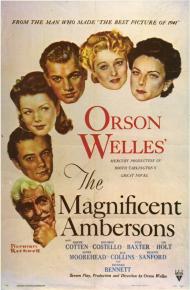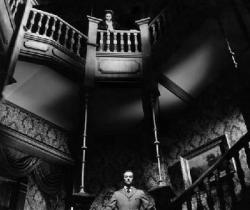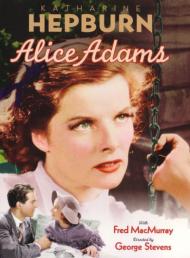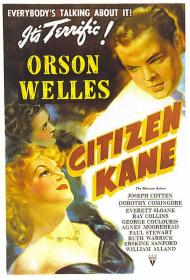Movie Review
The Magnificent Ambersons
Orson Welles' Mercury Production of Booth Tarkington's Great Novel
US Release Date: 07-10-1942
Directed by: Orson Welles
Starring▸▾
- Joseph Cotten, as
- Eugene Morgan
- Dolores Costello, as
- Isabel Amberson Minafer
- Anne Baxter, as
- Lucy Morgan
- Tim Holt, as
- George Amberson Minafer
- Agnes Moorehead, as
- Fanny Minafer
- Ray Collins, as
- Jack Amberson
- Erskine Sanford, as
- Roger Bronson
- Richard Bennett, as
- Major Amberson
- Don Dillaway, as
- Wilbur Minafer
- Orson Welles as
- Narrator (voice)

Agnes Moorehead looks down upon Tim Holt in The Magnificent Ambersons.
The Magnificent Ambersons was Orson Welles' follow-up to his audacious movie debut Citizen Kane. It was based on the 1918 novel by celebrated Midwestern author Booth Tarkington. The Indiana born Tarkington is one of just three writers to win the Pulitzer Prize in fiction more than once (the others are William Faulkner and John Updike). Tarkington won for his novels The Magnificent Ambersons and Alice Adams, both of which would be made into celebrated motion pictures. He was famous for writing homespun stories set in small town America's heartland.
As you might expect, the movie focuses on the Ambersons, the wealthiest family in their small Indiana town. It concerns several generations during the final decades of the 19th Century. The story is narrated by the mellifluous voiced Welles himself. He sets the scene by describing different quaint customs of the day. We learn about the ostentatious Amberson mansion, built in 1873 by Major Amberson. We see his daughter Isabel (Dolores Costello) being courted by the rather wild Eugene Morgan (Joseph Cotten) but choosing instead to marry the dull and thoroughly unassuming Wilbur Minafer. Eugene, meanwhile, leaves town for parts unknown.
Wilbur and Isabel have one child. A boy they name George Amberson Minafer (Tim Holt). They proceed to spoil him rotten and he quickly becomes the terror of the town. Everyone, it seems, is awaiting the day - with bated breath - when George will finally receive his comeuppance.
20 years or so pass by and Eugene returns, a success in the fledgling auto industry and with his grown up daughter Lucy (Anne Baxter) in tow. George immediately falls for Lucy while Eugene and Isabel quickly realize they never stopped loving each other. After a few dramatic shifts, the Amberson family fortune dissipates and the story heads towards its conclusion.
Although it's brilliantly acted and directed, this is a truncated version of Welles's original 2 hour plus epic. After a disastrous preview RKO recut the movie while the director was in South America working on another film production. They also reshot the ending to make it more uplifting.
The Magnificent Ambersons was first screened for a preview audience shortly after the events of Pearl Harbor, hence the extremely negative response to what was seen as a long depressing story about the decline of an American family. The edited footage was evidently destroyed as none of it has ever been found to exist. The main thrust of the story remains intact but the plot does seem to jump around at times and you definitely get the feeling that some scenes are missing.
The cast is great, with Agnes Moorehead deserving of a special mention as Fanny, George's nutty and bitterly jealous, old maid aunt. She has a couple of memorable scenes including one with George as they ascend the Amberson family mansion's grand staircase. The mansion itself was an elaborate set built with four walls and ceilings in every room to enable the director to film from any angle (see photo). It represents the fortunes of the Ambersons and is a central figure in the story, around which the other character's lives revolve.
Orson Welles's interest in this story was personal. You see, Booth Tarkington was a close family friend of the Welles's when Orson was growing up. Like the boy in the story, Orson had a reputation as a spoiled brat and his real first name was George. Orson therefore believed he was the inspiration for the character in the novel. With Citizen Kane he created a cinematic ogre based on William Randolph Hearst, with The Magnificent Ambersons he proved he could take it as well as dish it out by painting a very unflattering portrait of a character he believed to be based on himself.
SPOILER ALERT:
Narrator: “Something had happened. A thing which, years ago, had been the eagerest hope of many, many good citizens of the town, and now it had come at last; George Amberson Minafer had got his comeuppance. He got it three times filled, and running over. But those who had so longed for it were not there to see it, and they never knew it. Those who were still living had forgotten all about it and all about him.”
After this final narration the original movie, as Welles intended it, included a panning camera shot roaming the empty, decaying rooms of the Amberson mansion. This footage was cut, while RKO added the happier ending where George and Eugene reconcile. Although, ironically, this new ending was closer to the denouement in the Tarkington novel.
At any rate, The Magnificent Ambersons is a worthy follow-up to one of the greatest directorial debuts in movie history. The surviving theatrical version runs just a hair under 90 minutes and is a nostalgic homage to a much simpler time and place, as well as a cautionary tale about the consequences of selfishness and the refusal to change with the times. The Magnificent Ambersons represents one of the greatest travesties ever perpetrated by a studio on a director's vision but it nevertheless remains a must see for serious movie buffs.
Photos © Copyright RKO Radio Pictures (1942)

![3.5 star[s] out of 4](http://www.threemoviebuffs.com/static/images/global/featured_gold_stars.png)

